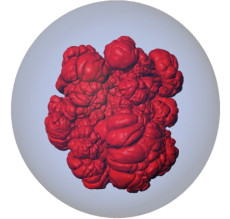Type Ia Supernovae
Update: Recent Berkeley Lab Computing Sciences News about supernovae: read more...
Key Challenges: Understanding Type Ia supernovae (SNe Ia) from first principles is difficult because simulation results are quite sensitive to how the thermonuclear runaway is ignited (e.g., at the center or slightly off center on one side); to the details of turbulent (nuclear) combustion once ignition is achieved; and to the multi-dimensional treatment of radiation in an exploding medium that may not be in thermal equilibrium. The science is treated as four separate, consecutive computational problems with separate codes for each. Each problem requires 3D with as fine a resolution as is feasible. Turbulence is a key ingredient.
Why it Matters: A supernova is a cataclysmic explosion of a giant star remnant that has completed its normal life cycle and has ceased nuclear fusion. A Type Ia supernova emits a particular light spectrum and is thought to originate from a particular type of star called a white dwarf. The majority of SN Ia explosions occur far away from our galaxy; yet, due to their enormous intrinsic brightness, outshining billions of stars, we can observe them. Their light represents a time when the universe was only about half its present age. Therefore, they can be used to determine the geometry and the expansion rate of the universe. Current measurements of them suggest that the universe is undergoing an accelerated expansion – a result which fits the General Relativity if a yet unknown form of “dark” energy is assumed to dominate the universe today. Thus, the study of SNe Ia may have given birth to a major revision of our understanding of physics and of the universe.
Accomplishments: A new method, developed in large part on NERSC supercomputers, treats the convective phase of Type Ia supernovae using a low Mach number hydrodynamics approach embodied in the MAESTRO code that includes stellar equations of state and nuclear reaction networks. This numerical method is required to resolve conditions in the star over time scales much longer than typical approaches. The subsonic approach along with adaptive mesh refinement allow much higher effective resolutions.
Investigators: Stan E Woosley, Daniel Kasen, Haitao Ma (UC Santa Cruz); John Bell, Ann Almgren, Andy Aspden, Andrew Nonaka (LBNL); Michael Zingale, M. J. Malone (SUNY Stony Brook)
More Information: See The Astrophysical Journal Supplement Series, 188:358–383, 2010 June, and the MAESTRO code web site








